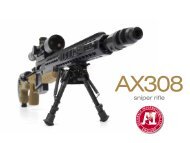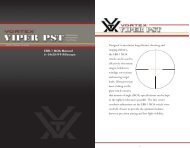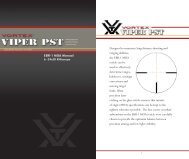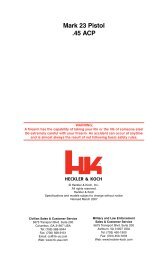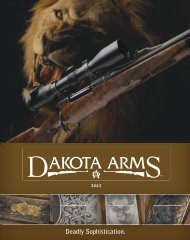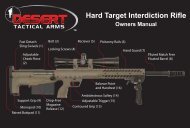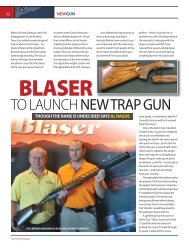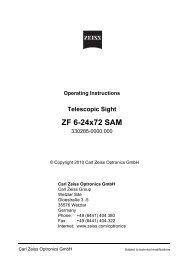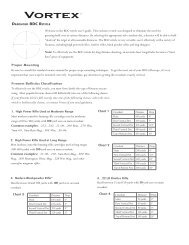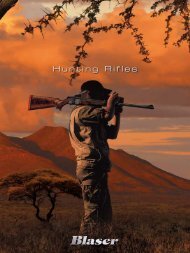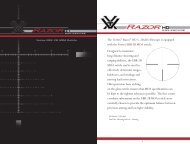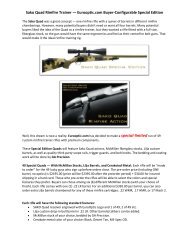Vortex 4-16x50 EBR-1 MOA reticle manual - Euro Optics Ltd.
Vortex 4-16x50 EBR-1 MOA reticle manual - Euro Optics Ltd.
Vortex 4-16x50 EBR-1 MOA reticle manual - Euro Optics Ltd.
- No tags were found...
Create successful ePaper yourself
Turn your PDF publications into a flip-book with our unique Google optimized e-Paper software.
SECOND FOCAL PLANE<strong>Vortex</strong> <strong>EBR</strong>-1 <strong>MOA</strong> ReticlePRECISIONSHOOTINGTACTICAL<strong>EBR</strong>-1 <strong>MOA</strong> Manual4–<strong>16x50</strong> RiflescopeDesigned to maximize long distance shooting andranging abilities,the <strong>EBR</strong>-1 <strong>MOA</strong><strong>reticle</strong> can beused to effectivelydetermine ranges,holdovers, windagecorrections andmoving target leads.Ultra precisionlaser etching onthe glass <strong>reticle</strong> ensures that minute of angle (<strong>MOA</strong>)specifications can be kept to the tightest tolerancespossible. The fine center crosshair subtensions on the<strong>EBR</strong>-1 <strong>MOA</strong> <strong>reticle</strong> were carefully chosen to providethe optimum balance between precision aiming and lowlight visibility.1
<strong>MOA</strong> SubtensionsThe <strong>EBR</strong>-1 <strong>reticle</strong> is based on minute-of-angle (<strong>MOA</strong>)subtensions. Many shooters areEstimating <strong>MOA</strong>very familiar with the <strong>MOA</strong>Although 1 <strong>MOA</strong> is verysystem used in hunting riflescopes.commonly corresponded to 1<strong>MOA</strong> measurements are based oninch at 100 yards, this is notdegrees and minutes: 360 degreesquite correct 1 <strong>MOA</strong> at 100in a circle, 60 minutes in a degreeyards equals 1.05 inches.for a total of 21,600 minutes.Calling 1 <strong>MOA</strong> an inch perThese angular measurements100 yards may be acceptableare used to estimate range and at shorter distances, but itcorrect for bullet trajectory will cause a fi ve percent errordrop in riflescopes. 1 <strong>MOA</strong> will in ranging and holdovercorrespond to 1.05 inches at a 100 adjustments. This will resultyard distance, 2.1 inches at 200 in missed shots at longeryards, 3.15 inches at 300 yards, distances.and so on.In this second focal plane riflescope, the listed <strong>MOA</strong>subtensions are only valid at the highest magnification ofthe scope. However, by understanding the relationship ofmagnification and subtensions, ranging, holdovers and winddrift can still be calculated at partial magnifications. Ifmagnification is set at 1/2 of full magnification, subtensionvalues will be two times the <strong>manual</strong> listed spec. Ifmagnification is set at 1/3 full magnification, subtension valueswill be three times the <strong>manual</strong> listed spec. If magnification isset at 1/4 of full magnification, subtension values will be fourtimes the <strong>manual</strong> listed spec.<strong>EBR</strong>-1 Reticle SubtensionsTo help calculate ranges, holdovers and wind drifts atmagnifications other than full power, the Viper PST4–<strong>16x50</strong> riflescope uses a dual number marking system onthe magnification dial. The 1x, 2x, 3x, and 4x subtensionmultiplier markings on the back side of the magnificationnumbers can be used in conjunction with the <strong>reticle</strong> to helpcalculate distances and holdovers at varying magnifications.Heavy crosshairsubtends 1.5 <strong>MOA</strong>Model4–<strong>16x50</strong>Reticlesubtensionsvalid at 16x5 <strong>MOA</strong> 2 <strong>MOA</strong>RiflescopeMagnification16x8x5.3x4xFine crosshairsubtends .1 <strong>MOA</strong>2 <strong>MOA</strong>4 <strong>MOA</strong>s6 <strong>MOA</strong>s8 <strong>MOA</strong>sGap subtends1.5 <strong>MOA</strong>Subtension Changes with MagnificationReticleMultiplier1x2x3x4xActual Subtensionof 2 <strong>MOA</strong> Reticle Space2 3
Ranging<strong>MOA</strong> measurements are very effective for rangingusing a simple formula. To use this formula, theshooter needs to know the size of the target or nearbyobject in inches.Example<strong>MOA</strong> Ranging FormulaTarget Size (Inches) x 95.5Measured <strong>MOA</strong>s=Range (Yards)Using either the vertical or horizontal <strong>MOA</strong> scale,place the <strong>reticle</strong> on a target of known dimensions andread the number of <strong>MOA</strong>s spanned. You will obtainmaximum accuracy in ranging by calculating exact<strong>MOA</strong> measurements. <strong>MOA</strong>s should be estimated in1/4s if possible.Accurate measuring will depend on a very steadyhold. The rifle should be solidly braced using a rest,bipod or sling when measuring. Once you have anaccurate <strong>MOA</strong> reading, use the formula to calculatethe distance.Ranging a man (39 inches from groin to top of head)at 6 <strong>MOA</strong>s yields 621 yards.39 x 95.5= 621 Yards6 <strong>MOA</strong>Note: In the <strong>MOA</strong> ranging formula, a shooter may substitute 100 for95.5 in the interest of speedier calculations. Be aware that this willproduce a fi ve percent over-estimation error of the yardage distanceobtained.4 5
Elevation HoldoversOnce the distance has been calculated using the<strong>EBR</strong>-1 <strong>MOA</strong> <strong>reticle</strong> or a laser rangefinder, the<strong>EBR</strong>-1 can be used for rapid holdover correction forbullet drop of the cartridge being used. To get themost benefit out of the <strong>EBR</strong>-1 equipped riflescope,<strong>Vortex</strong> <strong>Optics</strong> highly recommends shooters learntheir bullet drop numbers in <strong>MOA</strong>s rather thaninches.ExampleSince the <strong>EBR</strong>-1 <strong>reticle</strong> is scaled in 2 <strong>MOA</strong>increments, it is an easy job to quickly select thecorrect drop reference line once the shooter knowsthe bullet drops in <strong>MOA</strong>s. If the shooter prefers todial come ups for bullet drop using the elevationknob, knowing bullet drops in <strong>MOA</strong>s rather thaninches will allow for much faster adjustments as the<strong>MOA</strong>s can be quickly read on the elevation knob.17.5 <strong>MOA</strong> <strong>reticle</strong> holdover for 625-yard shot. No wind.6 7
Windage and Moving TargetsThe <strong>EBR</strong>-1 <strong>MOA</strong> <strong>reticle</strong> is highly effective whenused for wind and moving target leads. Using the<strong>reticle</strong> for effective windage and moving targetleads will require thorough knowledge of yourweapons system’s ballistic performance undervarying conditions and experience in readingwind strengths and target speeds. As in bulletdrops, it is important for the shooter to learna particular weapon’s windage/moving targetcorrections in <strong>MOA</strong>s rather than inches. Alwayshold the <strong>reticle</strong> into the wind.Example10 mph windFull value wind at 90 degreesBasic windage correction on center crosshairWhen dialing elevation come ups, the centerhorizontal crosshair will be used for windage ormoving lead corrections.3 <strong>MOA</strong> <strong>reticle</strong> windage correction for 400-yard shot in 10 mphcrosswind using center crosshair. Elevation adjustment alreadydialed into rifl escope.8 9
Basic windage correction using drop line on <strong>reticle</strong>When using the <strong>reticle</strong> for elevation correction ratherthan dialing, the <strong>MOA</strong> marks on the center horizontalcrosshair can still be used to help visually referencewindage corrections. Remember to hold the <strong>reticle</strong> intothe wind.ExampleBasic moving lead correctionWhen estimating moving target leads, the <strong>MOA</strong> markson the center horizontal crosshair can be used. Estimatingmoving target leads will require knowing yardage distance,wind speed, moving target speed, and total bullet flight time(including rifle lock time). Bullet flight times can be roughlycalculated based on fps velocities or a ballistic calculator.Note: Correctly estimating moving leads is very diffi cult and requiresconsiderable practice and knowledge beyond the scope of this <strong>manual</strong>.Example20 mph windFull value wind at 90 degreesWalking Direction8 <strong>MOA</strong> <strong>reticle</strong> windage correction for 500-yard shot in 20 mphcrosswind using 12 <strong>MOA</strong> <strong>reticle</strong> drop line.9.4 <strong>MOA</strong> <strong>reticle</strong> correction for a man walking 3 mph at a distance of800 yards. No wind. Total bullet time of fl ight from trigger pull 1.5seconds during which man travels 6.6 feet. Elevation already dialedinto turret.10 11
<strong>Vortex</strong> Service and Repair PolicyUnconditional Lifetime Warranty<strong>Vortex</strong> <strong>Optics</strong> wants you to shootand use your Viper PST riflescopeunder any conditions withcomplete confidence—that’s whyour warranty is straightforwardand simple:• Fully transferableUnconditional LifetimeWarrantyvortexoptics.com• No warranty card needed• No receipt neededRest assured, if this riflescope should ever require repair, allyou need to do is contact <strong>Vortex</strong> for absolutely free service.Call 800-426-0048 or e-mail service@vortexoptics.com.<strong>Vortex</strong> <strong>Optics</strong>2120 West Greenview DriveMiddleton, Wisconsin 53562USAPatent PendingDual Use: Shooting Tactical / HuntingManual #R-416S1-A12



